This was published 1 year ago
‘Napalm it all’: Desperate calls to stop cactus menace spreading across Australia
Smothered in long, sharp spines shaped to stay put wherever they penetrate, the Hudson pear is a fast-spreading horror for our wildlife and livestock – as well as the occasional human. The other thorny issue: how to get rid of it.
By Tim Elliott
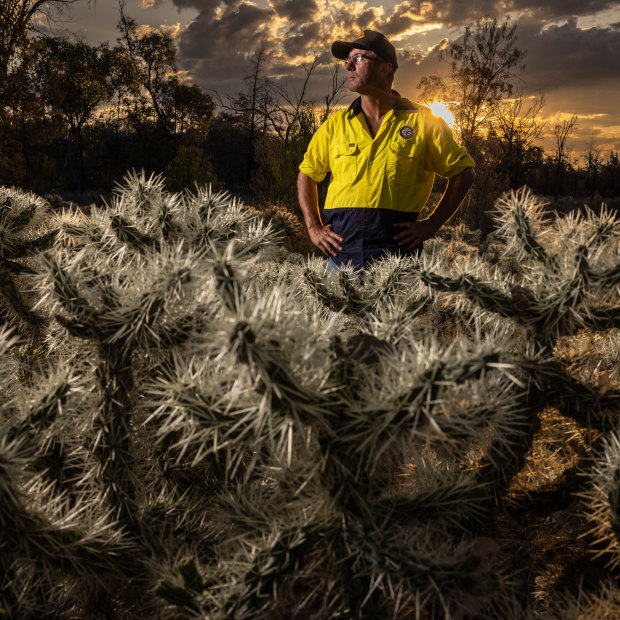
Local council weeds officer Mat Savage surrounded by Hudson pear on a property near Lightning Ridge, NSW. “It’s a disaster,” he says.Credit: Paul Harris
There are lots of reasons to visit Lightning Ridge. There are the outback sunsets, the stars, the hot springs, and the locals, including the kind and gentle woman behind the front desk of my motel who calls me “darl” like she actually means it and would, I am sure, have come out and helped me change the tyre on my car, had I asked her. There is also, of course, the opal. Lightning Ridge, in NSW’s far north-west, is one of the most storied opal-mining towns in Australia, home to the famous and exceedingly expensive black opal, which can fetch up to $15,000 per carat. But I didn’t come for any of this. No, I came for a cactus. And not just any cactus, but Cylindropuntia pallida – aka Hudson pear, aka “jumping cactus”, aka Australia’s next big environmental catastrophe. “It’s a disaster,” says local council weeds officer Mat Savage. “I hate the stuff.”
It’s a dry morning in mid-July and Savage has driven me into the bush outside town, where we’ve embarked on a walk in search of the cactus. He’s wearing jeans, glasses, a high-vis vest and a black, council-issued cap embroidered with a bright yellow Hudson pear struck through with a bold red line. Savage, 46, is originally from the Blue Mountains, west of Sydney, where he was a sheet-metal worker. In 2016 he moved to Lightning Ridge and began working for Castlereagh Macquarie County Council (CMCC), a local government authority dedicated to weed eradication. The council employs five weeds officers, but Savage is solely responsible for a 2.2-million-hectare area around Lightning Ridge, the scale of which would plunge most people into a state of catatonia. Savage, however, approaches it with a cool equanimity and a realisation, perhaps, that having a nervous breakdown would be a waste of energy.
Like most city people, I’d never heard of Hudson pear. But up here it’s a part of the collective unconscious, the stuff of newspaper articles, Facebook pages and pub talk. It is demonically persistent and rabbit-like in propagation, not to mention fanged from the ground up in five-centimetre-long spines which are heinously sharp and pearly smooth, and can pierce leather and even car tyres. “They’ll go straight through the sole of your shoe,” says Savage, who is walking ahead of me in thick-soled boots. “So watch your step.”
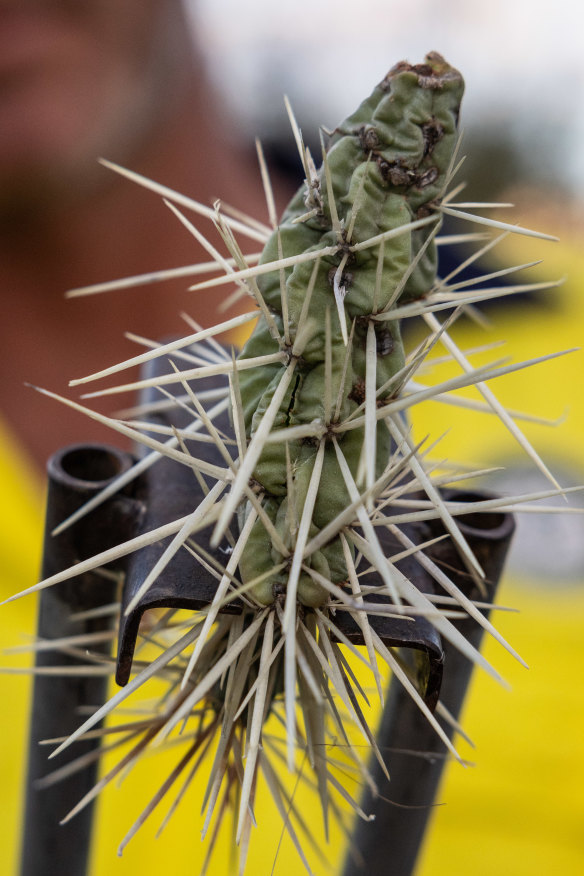
The sharp spines can grow five centimetres long.Credit: Paul Harris
It’s not long before we find an infestation, a roughly 300-square-metre swath set among a thin stand of gums. The word cactus has always reminded me of something small and domesticated, a plant people grow in pots on their windowsill. But standing before a Hudson pear is to be in the presence of something altogether different. They are big, for one thing, three metres across and two metres high, and creepily animate, their long, ropey, arachnoid arms queasy-green and alive with spines, the number and density of which make the plant appear to vibrate minutely, quivering with malignant potential. From a distance, this thorny pelt lends the cactus a pale radiance, like a dusting of snow. Up close, however, the plant is plainly and irredeemably repellent.
I peer closely at the spines, which are reverse-barbed and difficult to extract without pliers. “If calves get them in their mouths their mums won’t let them feed, and they starve to death,” Savage says. “If a dog gets in them the first thing they do is try to bite them out, and the spines get in their mouths and pin their jaws together.” According to the Queensland Department of Farming, Fishing and Forestry, the plant has caused at least one human fatality – a local man who fell into a patch some years ago and had a heart attack. The cactus is now rendering large areas of agricultural land unusable; you can’t farm it or muster on it; you can’t even walk through it. It may as well be radioactive.
Savage bends down, picks up a stick and knocks off a small section, or cladode, which falls to the ground, bouncing, almost daintily, on its spines. “The pieces come off so easily,” he says. “You only need a bit half the size of your thumb to get on the ground and it’ll send down roots.” Its transmissibility is almost viral. Rivers can sweep it downstream. A kangaroo might go for days with a piece of it in its fur. A car can carry it for thousands of kilometres stuck in its tyres or undercarriage.
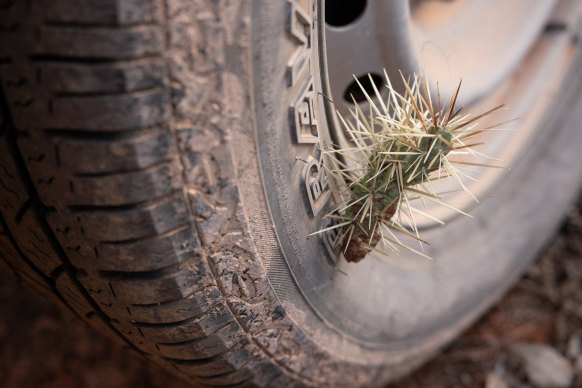
A vehicle can carry the Hudson pear far and wide in its tyres or undercarriage.Credit: Paul Harris
In its native home of Mexico it’s kept in check by local predators, including moths, flies and beetles. But out of its natural habitat, absent its enemies, the plant has run wild, including in South Africa and Namibia. But the worst-affected country is Australia, where the plant is popping up in Western Australia and Queensland, in the Northern Territory and the ranges around Adelaide. It is illegal to give away or sell the plant in Australia, but it has also been found for sale in a market in Melbourne, and as a decorative shrub beside a tennis court in Lindfield, on Sydney’s north shore. In NSW, where it first appeared, the government has estimated its potential damage at $536 million.
After a time, we return to Savage’s car. On the drive back into town, I stare out the window at the bush going by. When Savage drove me out here I hadn’t noticed anything unusual, but now that I know what to look for I can see the cactus dotted through the bush, hiding under trees and clumping together, biding its time, waiting for something to hurt.
There are two main theories about how Hudson pear got to Lightning Ridge. The first is that a Californian miner brought it with him in the 1960s to protect his claim from “ratters”, or night thieves; the second is that it arrived in the 1950s from Argentina and was planted in a nursery in Glengarry, about 70 kilometres south-west of Lightning Ridge. (Apparently, an old-timer named Ken Dawson would have been able to clear all this up, but unfortunately he died a week before I arrived.)
It doesn’t feel surprising that the plant should flourish in Lightning Ridge, a place with a reputation for being hardy, adaptive and ornery. The streets here are broad and flat, as if squashed by the enormous sky. Some parts of town are as politely kempt as any monied suburb in Sydney or Melbourne, but others resemble an industrial park after a cyclone, their front yards strewn with drill bits, propane tanks and car batteries. The biggest building by a factor of 15 is the bowling club, a blazing neon death star of a structure with Keno on a dozen screens and carpet the colour of orange-ripple ice cream. Shops have signs reading OPAL CAVE PRICE WAR and OPAL WHOLESALERS. There is no permanent police presence: the nearest station is in Walgett, 50 minutes’ drive south. On my first day in town, a man drives past me drinking a beer. At 3pm. “People are able to live a different kind of life here,” says Victoria Lugovoy, who manages the Lightning Ridge Opal Area Reserve, a 20,282-hectare area south of the town, which includes many of the mining claims. “People aren’t going to check up on you. You can start a whole new life and be whoever you want.”
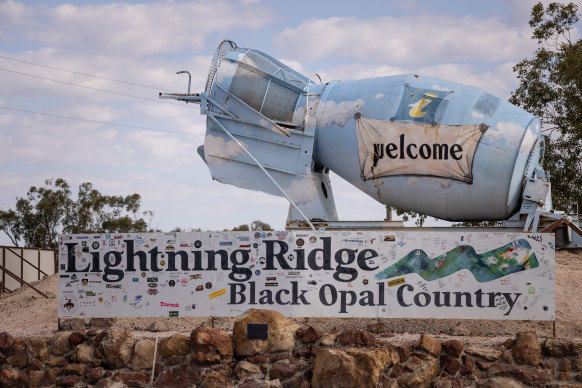
Hudson pear was named for the Lightning Ridge local who first identified the infestation in the 1990s.Credit: Paul Harris
This culture of individualism has made the town what it is, a picaresque tapestry of impecunious prospectors and assorted fringe-dwellers, of wall-to-wall roadkill and Wake in Fright-level drinking. But it has also complicated efforts to control the cactus. Bands of locals and Work-for-the-Dole crews have often headed into the bush to spray the plant with poison, but spraying requires unfaltering attention to detail (every square centimetre of the plant must be drenched for the poison to work) and regular follow-ups. Besides, there’s too much to spray. The CMCC has contracted spray teams, but infestations are often among dense, inhospitable scrub, a long way from viable access routes.
The plant is extraordinarily hardy. Savage has seen it growing on bare rock. He’s seen it growing two metres up in the fork of a tree. He’s seen it growing on a piece of corrugated iron. Once, as an experiment, he placed a piece of it in an empty jar and taped up the lid. After 18 months, he opened the jar. The plant looked dead, but a week later it had grown shoots. For the longest time, nothing put a dent in it: not 50-degree heat or minus-zero temperatures, not people digging it up with crowbars or burning it with blowtorches. (Unless you incinerate the roots, it’ll just regrow.) “I had one farmer tell me the only way to get rid of it is to napalm the whole area,” Savage tells me. “Get everyone out of town and napalm it all. And he was serious.“
There are plenty of Hudson pear horror stories – of people yanking the spines out with pliers; of falling face-first and getting the spines in their eyes. But the story I like best involves Jeff Ainsworth, one-time miner and full-time recluse who lives four kilometres from town. Sometime between 2005 and 2010 (he can’t remember exactly), Ainsworth was walking around his property when he stumbled backwards into a patch of the cactus. He was wearing a T-shirt, shorts and thongs. His nearest neighbour was perhaps 400 metres away. He lay there on his back, in the cactus, unable to get out, screaming for two hours. “Every time I moved, the spines pulled me in deeper, like a Venus flytrap.” Finally, his neighbour arrived and called an ambulance. By the time the ambos extracted him he was bristling with hundreds of spines – “so many I looked like a bird with feathers” – including under his toenails.
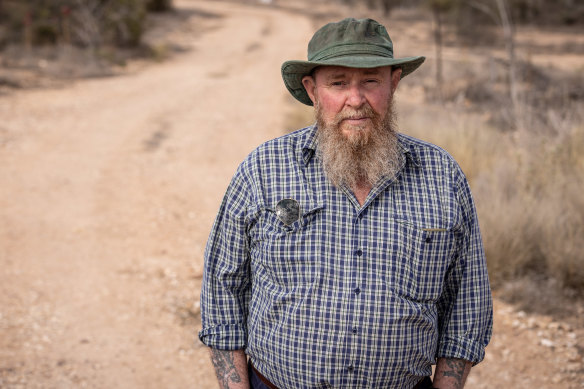
Jeff Ainsworth, who took three months to recover from his Hudson pear encounter: “Every time I moved, the spines pulled me in deeper.”Credit: Paul Harris
The nurses at Lightning Ridge hospital set about extracting them, one by one. But every time they did so, the spine’s barb brought with it a small piece of flesh. The pain was such that Ainsworth decided to leave many of the spines in there. “You let them fester,” he says. “When they get all pusy, it’s easier to pull them out.” It was a trick he’d learnt for removing splinters while splitting fence posts in a previous life.
It took him three months to recover.
People assume the Hudson pear is named for the person who introduced the cactus to Australia. In fact, it’s named after a Lightning Ridge local who, in the mid-1990s, first brought the problem to the attention of the then-Prickly Pear Destruction Commission. At first, the government tried to deal with it using herbicide sprays. When that didn’t work, they turned to biocontrol, a long-established method of controlling pests by targeting them with their natural enemies.
It turned out that the Hudson pear’s principal predator is a tiny scale insect called cochineal. Native to Mexico and South America, the cochineal is an extraordinary bug, long prized as the sole source of carmine, a purplish-red pigment that the Aztecs, among others, used to dye their textiles. (It was also used to produce the vibrant red robes worn by Catholic cardinals, and for the British army’s distinctive “redcoat” uniform.)
There are lots of different types of cochineal bug, none of which is native to Australia, which explains why the cactus grows so well here. It was only after multiple trips to Mexico in the early 2000s that Australian scientists identified the precise cochineal lineage they needed, the catchily named Dactylopius tomentosus californica var. parkeri. But the wheels of science move glacially, and it wasn’t until 2015 that they got approval to bring it into Australia. It was another two years before the bugs were released.
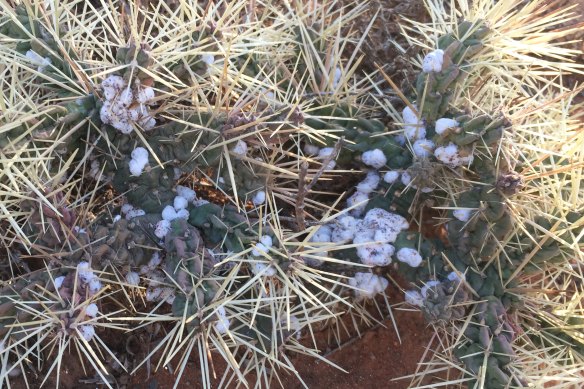
Cochineal bugs attacking the cactus.Credit: Courtesy of Mat Savage
Since 2017, Mat Savage has been rearing vast quantities of the insect on pieces of the cactus that he keeps in a greenhouse out the back of Lightning Ridge. He then takes these inoculated cladodes into the bush and places them in areas where the infestation is particularly bad. Over time the bug takes over, draining the cactus of nutrients before spreading to its neighbours.
Or that’s the idea. Unfortunately, 2021 and 2022 brought unseasonably heavy rains, which washed the cochineal off the plants. Savage set about furiously breeding more bugs, but the cactus had by then become a political issue, with local candidates using it to criticise the incumbent LNP government. In late 2022, in the lead-up to the state election, the local member, the Nationals’ Dugald Saunders, announced a $2.6 million Hudson Pear Control Program. The funds would get the bugs back on track, buy free spray for landholders and pay for two full-time positions to oversee the program until 2027.
“That’s what I reckon they should do – get the army out here with flamethrowers.”
Jon Slack-Smith
The program is a big deal. “Two point six million is an exceptional amount of money to pump into this problem, especially compared to other invasive plant species,” says Andrew McConnachie, senior research scientist with the Weed Research Unit at the NSW Department of Primary Industries. It’s an indication of how seriously the government is taking the issue. “If we let it go, it’ll be extremely damaging.”
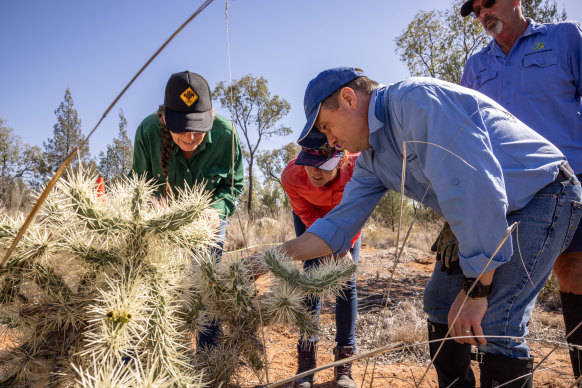
Andrew McConnachie examines a Hudson pear, which he calls “prickly pear on steroids”.Credit: Paul Harris
By the time of Saunders’ announcement, however, some locals had lost faith. Exhausted from spraying and with the bug in abeyance, they began dreaming anew of a cleansing fire, of napalm and butane. Or at least a couple of flamethrowers. “That’s what I reckon they should do,” says Jon Slack-Smith. “Get the army out here with flamethrowers.”
Slack-Smith, who is 36, owns a 2023-hectare plot at Cumborah, south of Lightning Ridge. His land is flat and sun-cooked, with miserly-looking, hard-packed soil punctuated by stiff little quivers of spear and buffel grass. In fact, as Slack-Smith explains, the property would be perfectly usable if not for the fact that it hosts one of the area’s worst infestations of Hudson pear, a shimmering sea of spines that induces in Slack-Smith an inertia of disgust and impotence. “I’d like to bulldoze it,” he says, standing on the edge of the infestation. “Divide it into sections and bulldoze it, and then bury it all in a big hole. Or burn it. See how that goes, just as a trial.”
I mention the cochineal, but Slack-Smith shakes his head. He’s not a huge fan of the bug, or of Mat Savage, for that matter. “This was one of the first release sites. Five years the bug’s been here, and look at it now! It’s overrun!” But what about all the rain, I say. Wouldn’t it have washed the bug off? “Yeah, okay, but we can’t rely on a drought to make it work. As soon as we see a good season, the cactus will come back again.”
He puts a hand up to shield his eyes and swivels on his heels, as if he’s in the crow’s nest of a tall ship, scouring the horizon for land. “The bug’s not working. And if Hudson pear gets into the Barwon River, and then down into the Murray Darling, it’ll be all over NSW, and it’ll cost billions to fix, not millions.”
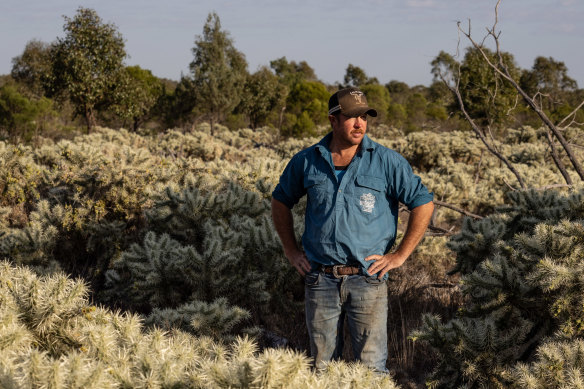
Jon Slack-Smith on his Hudson pear-infested property at Cumborah, south of Lightning Ridge.Credit: Paul Harris
Lightning Ridge was first settled in the mid-1800s, but it wasn’t until 1902 that opal was discovered. The find brought an influx of miners and by 1910, the population was about 1000. In the old days, miners dug shafts with picks and shovels. These days, anyone with any money uses a drill and a “blower”, a thick plastic pipe that snakes down the shaft, which can be as much as 30 metres deep, and vacuums up the mullock from the bottom. They are extremely noisy, not to mention expensive: you might use 200 litres of diesel – $300 worth – in three days. But if you can’t afford a blower, you have to use a wheelbarrow and a hoist, which makes $300 look cheap. To share the costs and the labour, most miners have a partner.
Mining has transformed the landscape here. The land around town, and south in the mining area of Grawin in the Lightning Ridge Opal Area Reserve, is scarred and blasted, a moonscape of mullock heaps and white, pebbly, irradiated-looking dirt. Nearby or beside each heap are shaft openings, a metre or two wide, some of which are haphazardly covered with old logs or tree branches and bits of mesh. (If a hole is covered, it’s still active. Dead mines should have their openings filled in, but not all do.) Each claim is 50 metres by 50 metres, often marked out by nothing more than a length of wire. Some have caravans with televisions and functioning toilets, others are just tin-roofed lean-tos that wouldn’t look out of place in a Mumbai slum. (Many of the miners only come up in winter – summer is too hot.)
According to Savage, a lot of these places “look shitty” on the outside but are perfectly liveable on the inside. “They don’t want people to think it’s worth breaking in.” Just to make sure, miners often stake signs around their claims, ranging from the standard “STAY OUT” and “NO VISITORS” to “ABSOLUTELY DO NOT COME HERE” and the rabid and positively cryptic “I DIDN’T NEED YOU THEN I DON’T NEED YOU NOW DON’T LOOK FOR ME NOW THANK YOU”.
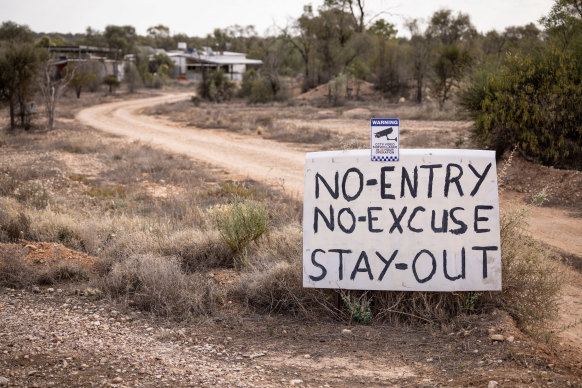
Opal miners often stake signs outside their claims to deter visitors.Credit: Paul Harris
There are about 3300 mining claims in Lightning Ridge. About half of them are in the Opal Area Reserve; the other half are on freehold farming land. (By law the miners are allowed onto farmland, so long as they pay the owner $120 per year per claim in compensation.) In the past, this has caused considerable tension, much of it focused on the cactus. Farmers have blamed miners for spreading it by moving their drill rigs from claim to claim, dragging bits of the plant with them. “Some [miners] do it on my land,” says farmer Bub Kelly, who owns 4800 hectares in Grawin. “But it’s hard to kick them off because it’s hard to catch them doing it.”
Kelly is testament to the Australian sun’s unrivalled capacity to prematurely age the human face. He is 55 but looks at least 70, even 75, with silvery, lichen-like facial growth and a piratical leer that is enhanced no end by the absence of his two front teeth and near-constant smoking. His family, which has been here since 1955, used to run sheep, but Hudson pear put an end to that. “The spines get in their wool and the f---in’ shearers don’t want to f---in’ shear it.” Now he increasingly farms the miners. He’s got about 700 claims on his land, bringing in about $75,000 a year. “It’s an income,” he shrugs.
Over the years, Kelly has straddled both worlds; a bit of farming here, a bit of mining there. “I done okay back in the 1990s, and made a good living. Now I get a few grand every now and then. Nothing serious. It’s different now, anyway. You used to know everyone, but now there are more junkies and thieves.”
Stealing from another person’s claim, or “ratting”, is not uncommon. Ratters usually enter a mine through an adjacent shaft, or they can chip into another person’s claim underground. “There was a couple of young guys who were caught doing it a while back,” says Kelly. Apparently, they got “a good hiding”, which, given the alternative, was an excellent outcome. “The best thing to do is drop them down a hole,” he says.
Before I came to Lightning Ridge, I’d assumed all the opal would have been mined out long ago. Nothing I saw here challenged that assumption. And yet the land was still being gnawed to pieces. Everywhere the earth felt bleak and dusty and brittle, so comprehensively honeycombed that it threatened to collapse, as per a Hollywood blockbuster, beneath my feet. The cactus seemed part of the same ecocidal pathology; eating the bush from within, metastasising in the scrub, a co-conspirator in the historic and seemingly irreversible despoliation of almost every corner of this country.
Australia has an excellent record of introducing foreign species that have gone on to trash the local environment. Witness the cane toad, the rabbit, the fire ant and, perhaps most pertinent to this story, the prickly pear, which was imported on the First Fleet. The colonists brought it as a vector for the cochineal bug (a different lineage to the cochineal in use today), with which they hoped to establish their own dye industry, then dominated globally by Spain.
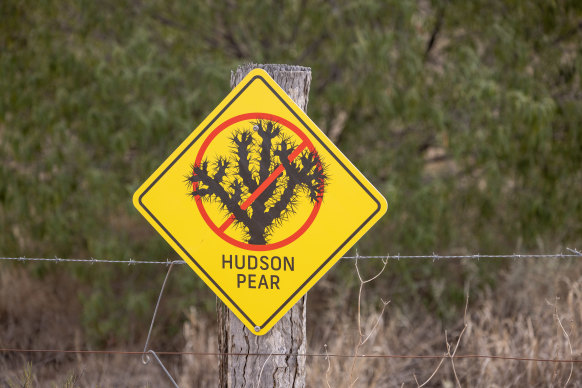
A warning of an infestation.Credit: Paul Harris
The cochineal bug was never intended to kill the prickly pear; if it had, there wouldn’t have been a cochineal industry. And so, when the prickly pear inevitably escaped, it had no natural predator. By 1920, it had infested more than 24 million hectares, an area about the size of the UK. In 1926, the government imported Cactoblastis cactorum, a South American moth that fed on prickly pear. By 1937, the plant had virtually disappeared, making Cactoblastis cactorum one of the world’s most successful examples of biocontrol. (In 1985, a sculpture of the moth was unveiled in the town of Miles, in Queensland, making it the only insect in Australia to have a statue erected in its honour.)
According to the DPI’s McConnachie, Hudson pear is “prickly pear on steroids”. And yet, there is no reason the cochineal bug can’t bring it to heel, especially if it is coupled with spraying. But it will take time. “Back in the 1930s, an average-sized moth population on a prickly pear could kill it in six to 10 months. The cochineal can take up to two years to kill a Hudson pear.” It’s not perfect, he says. “But what other option is there?”
One option would be to find a way of actually using the cactus. Like making a drink out of it – a Hudson Pear tequila, maybe. Jon Slack-Smith and his mates have certainly talked about this: “But then, none of us would be game enough to try it.” Mat Savage sometimes daydreams of crossbreeding Hudson pear with wheat to create a prolific and indestructible grain. And surely the spines would be good for something? An unrustable nail? Radical acupuncture?
Savage and McConnachie never use words like “eradicate” or “wipe out”. The cactus is here now, and it’s not going away. But its sting might be blunted. In a few years, you might not have to walk around the bush here with your eyes on the ground, watching for spines. It’s even possible that Savage might be able to go to bed at night and wake up in the morning without thinking about the cactus. I ask him if he’d be bored without it. “No,” he replies. “It just means I could start looking after the other two million hectares of my shire properly.”
To read more from Good Weekend magazine, visit our page at The Sydney Morning Herald, The Age and Brisbane Times.